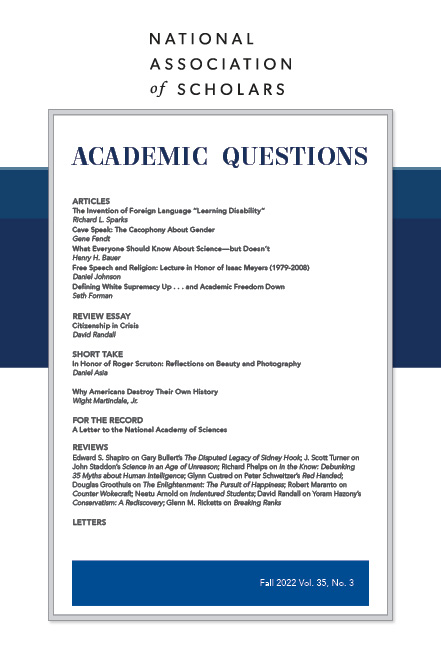Indentured Students: How Government-Guaranteed Loans Left Generations Drowning in College Debt, Elizabeth Tandy Shermer, Harvard University Press, pp. 400, $29.95 Hardcover.
Neetu Arnold is Senior Research Associate at the National Association of Scholars; [email protected]. She is the author of the NAS report Priced Out: What College Costs America (2021), a detailed analysis of the spending habits of fifty universities.
Editor’s Note: This piece was written prior to the Biden administration’s announcement offering targeted student debt relief, a policy that does not address the more serious issue of rising college costs discussed herein.
Student loans have been a major topic of discussion as the Biden administration grapples with the student debt crisis. It remains unclear whether the administration will follow through on its plans to forgive student loans for borrowers. In the meantime, forty-five million Americans still owe a massive $1.7 trillion in student loan debt. These debtors eagerly wait for any news of forgiveness, whether partial or complete.
Elizabeth Tandy Shermer, an assistant professor of history at Loyola University, is one of those debtors. Her book, Indentured Students: How Government-Guaranteed Loans Left Generations Drowning in College Debt (2021), presents a historical account of federal support of higher education—from the Federal Work Study program to the GI Bill to federal student loans.
Shermer tells a straightforward story: early efforts to fund higher education were based on direct federal funding, and the last sixty years of alternatives such as loans, grants, and other types of subsidies have been a mistaken aberration from those early ideas. College should be free for all, Shermer thinks, and any opposition to this idea comes from restrictive elitism—and probably racism.
Shermer’s perspective appears compelling due to its unified grand narrative of the American higher education system. Shermer’s story starts much earlier than most historical accounts of higher education subsidies, which primarily begin in the 1960s. Shermer is right to include this additional historical context. I did the same in my report Priced Out, where I argued that the GI Bill and the 1947 Truman Commission planted the seeds for the destructive “higher education for all” narrative.1 Indentured Students also provides detailed vignettes of conversations and debates between policymakers at each historical milestone, which gives readers a valuable understanding of the perspectives of various stakeholders.
Shermer, however, fails to interpret this rich historical context in an objective manner. She ignores or discounts plausible alternative theories about the causes of college unaffordability, such as rising tuition, and instead only presents her preferred arguments. She selectively critiques the intentions of those who do not share her worldview and uncritically quotes those she agrees with. As a result, Shermer’s conclusions about what must be done today do not hold up to any amount of scrutiny. In fact, her proposed solutions will only lead to more of the problems she decries in the first place.
Indentured Students begins its historical account by introducing readers to the Morrill Land Grant Act of 1862, the first form of federal assistance for higher education. The Act established several state-run universities which focused on agriculture and mechanic arts. The Land Grant Act made higher education a more feasible option for farmers and the working class who wanted to obtain some useful knowledge and skills.
The next major step to make college more affordable involved directly funding students. Shermer presents the New Deal-era work-study program, an early precursor to the current Federal Work Study (FWS) program. The work-study program of the 1930s under the National Youth Administration (NYA) was conceived against the backdrop of the Great Depression. The NYA work-study program provided work and education for Americans between the ages of 16 and 25. Shermer concedes that the program did not “help everyone in need, but, at its height, work-study supported one of every eight college students.”
For Shermer, the dedication to direct higher education funding pre-1950s was the gold standard. Afterwards, things started to go downhill. But it wasn’t because of increased federal involvement—it was because there wasn’t enough federal involvement. According to Shermer, direct federal funding at the time was stymied by issues of racial segregation and separation of church and state. Politicians had to balance the needs of many constituents with diverging interests. As a result, Republicans and Democrats alike settled for the federal student loan system, inspired by federal mortgage programs which turned renters into homeowners. Politicians believed the student loan program would provide the same results in a cost-effective, politically palatable way. Meanwhile, it seemed as if college graduates would land the kind of jobs that would make higher education a worthwhile investment and borrowers could make repayments without much struggle. Shermer writes that adopting the student loan system, however, did not consider the risks borrowing money posed to students and failed to keep up with skyrocketing costs of college.
But Shermer fails to provide a solid explanation as to why college costs skyrocketed. This is a crucial flaw in her argument, as the only reason the student loan system transformed into the student debt crisis is due to those costs. If tuition had stayed the same as it was in the 1960s, student loans would have been easy to pay off even for those with less marketable degrees. Instead of addressing this central issue, Shermer spends most of the remainder of the book listing the various times when higher education funding was cut, and implicitly ties this to rising costs. This is a version of the so-called “cheap states” theory, which echoes popular rhetoric from the higher education establishment. But the decreases in government funding are not large enough to account for the massive tuition increases, which I detailed in Priced Out.
The most glaring omission is that of the Bennett Hypothesis. Former Education Secretary William Bennett proposed in a 1987 New York Times article that federal student aid gave universities the ability to increase prices.2 Essentially, student aid increases the ability of students to pay for college, and thus colleges can charge higher prices without lowering enrollment. This explanation undermines the story Shermer presents, because it demonstrates that increased federal support can actually make college less accessible. But Bennett’s name appears only once in the entire 400-page book—and it refers to him as just another Reagan administration antagonist who despised welfare. It’s hard to view this omission as anything but intentional on Shermer’s part. In addition, several prominent economists have found evidence in support of the Bennett hypothesis in recent years.3
Indentured Students provides a plethora of quotes and perspectives from the past. These perspectives echo many of the debates today and deserve to be revisited and examined. But readers should approach the author’s historical interpretations with some caution.
Shermer relies on neo-Marxist secondary sources to read into the intentions of historical individuals. During the 1950s, there were several debates over who should receive federal assistance. Edith Green, a Democratic congresswoman from Oregon, believed the federal government should assist those with talent instead of solely focusing on need. Green, furthermore, wanted assistance targeted to middle class families, who struggled to send their children to college. Shermer, however, whittled down Green’s opinion to racial bias: “She [Green] shared the view of many who implicitly wanted to protect the white Americans who had benefited the most from the New Deal’s government-guaranteed financial products.”
Shermer cites three books about racism and welfare to “prove” Green’s intentions. Yet the very dissertation from which Shermer cites Green’s original quote provides a detailed section which discusses Green’s opposition to segregation and racial discrimination.4
Shermer fails to apply the same critical eye to those who share her views. She unquestionably accepts a Temple University administrator’s claim that “government aid had a tendency to strengthen rather than weaken the moral fibre [of students]” during the New Deal era. Surely, a university administrator would have ulterior motives to make such a claim since government aid was critical for the financial viability of mid-tier universities at the time. Yet, Shermer does not consider these motives for this administrator and the others she quotes to bolster her argument that increased government support did not dilute the quality of the student body. On the other hand, she attacks Harvard and Dartmouth administrators as elitists for believing federal funds would compromise their independence.
Shermer’s historical interpretations are unreliable, even if the plentiful quotes are useful information. But her book ignores the fundamental question of what caused rising tuition over the past sixty years. The answer to this question is crucial for determining the most appropriate solutions to the student debt crisis. Her claims of inequity, racism, and elitism are ultimately irrelevant if we don’t know how to make college affordable in the first place.
1 Neetu Arnold, Priced Out: What College Costs America, National Association of Scholars, March 2021, https://www.nas.org/reports/priced-out/full-report.
2 William Bennett, “Our Greedy Colleges,” New York Times, February 18, 1987.
3 Jenna Robinson, The Bennett Hypothesis Turns 30, The James G. Martin Center for Academic Renewal, December 2017, https://files.eric.ed.gov/fulltext/ED588382.pdf.
4 Naomi V. Ross, “Congresswoman Edith Green on Federal Student Aid to Schools and Colleges” (PhD diss., Pennsylvania State University, 1980).
Image: Adam Nir, Public Domain













